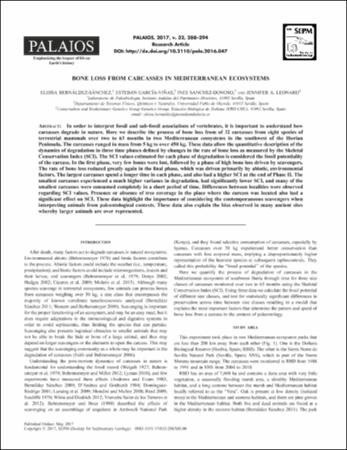
.jpg)
REPOSITORIO DE ACTIVOS DIGITALES
Depósito de documentos digitales reúne, difunde y preserva la documentación generada en los proyectos y actividades del Instituto Andaluz del Patrimonio Histórico.
https://hdl.handle.net/11532/327478
| Título : | |
| Autor : | Bernáldez Sánchez, Eloísa García-Viñas, Esteban Sánchez Donoso, Inés Leonard, Jennifer A. |
| Fecha de publicación: | may-2017 |
| Fuente : | Palaios, 2017, v. 32, pp. 288-294 |
| Tipo de documento: | Artículo publicación periódica |
| Provincia: | Huelva Sevilla |
| Otros descriptores toponímicos: | Península Ibérica Parque Natural Sierra Norte de Sevilla Parque Natural de Doñana |
| Descriptores temáticos: | Hueso Animales Cadáveres Fósiles Ecosistema Paleobiología Paleontología |
| Código ISO Idioma: | eng |
| Resumen: | In order to interpret fossil and sub-fossil associations of vertebrates, it is important to understand how carcasses degrade in nature. Here we describe the process of bone loss from of 32 carcasses from eight species of terrestrial mammals over two to 63 months in two Mediterranean ecosystems in the southwest of the Iberian Peninsula. The carcasses ranged in mass from 5 kg to over 450 kg. These data allow the quantitative description of the dynamics of degradation in three time phases defined by changes in the rate of bone loss as measured by the Skeletal Conservation Index (SCI). The SCI values estimated for each phase of degradation is considered the fossil potentiality of the carcass. In the first phase, very few bones were lost, followed by a phase of high bone loss driven by scavengers. The rate of bone loss reduced greatly again in the final phase, which was driven primarily by abiotic, enviromental factors. The largest carcasses spend a longer time in each phase, and also had a higher SCI at the end of Phase II. The smallest carcasses experienced a much higher variance in degradation, had signifiantly lower SCI, and many of the smallest carcasses were consumed completely in a short period of time. Differences between localities were observed regarding SCI values. Presence or absence of three coverage in the place where the carcass was located also had a significant effect on SCI. These data highlight the importance of considering the contemporaneous scavengers when interpreting animals from paleontological contexts. These data also explain the bias observed in many ancient sites whereby larger animals are over represented |
| Editorial : | Flagstaff: Society for Sedimentary Geology |
| ISSN: | MIAR 0883-1351 |
| Derechos: | © Instituto Andaluz del Patrimonio Histórico |
| Derechos URL: | https://creativecommons.org/licenses/by-sa/4.0/deed.es |
| Fecha de depósito: | 2019-04-15T12:27:07Z |
| Fecha disponible: | 2019-04-15T12:27:07Z |
| Formato: | application/pdf |
| URI: | https://hdl.handle.net/11532/327478 |
| DOI: | http://dx.doi.org/10.2110/palo.2016.047 |
| Aparece en las colecciones: | Artículos en publicaciones seriadas |
| Fichero | Descripción | Tamaño | Formato | |
|---|---|---|---|---|
| Bone loss from carcasses in Mediterranean ecosystems.pdf | 490,38 kB | Adobe PDF |  Ver |
Los ítems de IAPH están protegidos por copyright, con todos los derechos reservados, a menos que se indique lo contrario.
Exportar registro
Ítems relacionados
Bernáldez Sánchez, Eloísa; García-Viñas, Esteban; Gamero Esteban, Miguel; Ocaña García de Veas, Aurora; Leonard, Jennifer A.; Porta, Javier; Porta, Jose M.
Bernáldez Sánchez, Eloísa; García-Viñas, Esteban; Sánchez Donoso, Inés; Leonard, Jennifer A.
Alzaga García, Milagros; Gallardo Abárzuza, Mercedes; Higueras-Milena Castellano, José Manuel; Bernáldez Sánchez, Eloísa; García-Viñas, Esteban; Domínguez Delmás, Marta; Guijo Mauri, Juan Manuel; Cornellá, Anna; Leonard, Jennifer A.
Bernáldez Sánchez, Eloísa; García-Viñas, Esteban; Sanguino-González, Fernando; Leonard, Jennifer A.
Bernáldez Sánchez, Eloísa; García-Viñas, Esteban; Sanguino, Fernando; Villalon-Torres, David; Leonard, Jennifer








